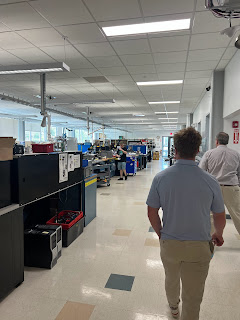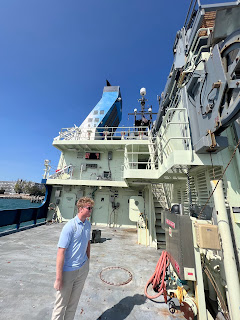Day 3
On our day three adventure we traveled to Woods Hole Oceanographic Institute. We met with three amazing people who showed us their work. We started with meeting Jim Flynn, the head of fundraising for WHOI. We got a debrief of what our day was going to look like while also learning about the organization.
The idea for WHOI all started in the early 1920s. The first of a series of conferences between Frank R. Lillie, then the
When meeting with Senior Scientist Christopher Reddy, who is a chemist there at WHOI. He talked to us about the type of plastics being used in our everyday bases such as straws. He showed us a different type of plastic that is created to break down in a shorter time span than a regular straw. He described to us how the plastic is broken down and what breaks it down. The sun is one of the biggest contributors to the breaking down process of plastic. A good reference he gave us today was a red solo cup. If you were to leave the cup in the sun for a few days you would notice that the side facing up towards the sun is going to turn pink. This is due to the fact that it is starting to be broken down. What the sun does is that it starts a penetration for microbes to start breaking down the plastic. The plastic doesn't go away and is returned to the earth as a nutrient instead what happens is the plastic gets broken down and turned into microplastics and then into nano plastics. The plastic becomes brittle and easy to break once started to break down leaving it easy to spread. Something that companies are starting to do is create thinner and thinner plastics to be able to break down faster. Something that Senior Scientist Christopher Reddy had been working on was looking at the tanker fire in Shrilanka where cargo ship Xpress Pearl Caught fire leading to 200 billion plastic nurdles being dumped into the ocean. Lots of the nurdles caught fire leading to a new type of plastic that was hard and brittle. This was worse to track in the ocean due to the uncommon shape of the new plastic which can be floating around the ocean in any type of pattern where as the nurdles are all the same and will travel together. The new plastic breaks down and turns into what seems like a speck of dust, but don't be fooled it's only a smaller version of itself.
Senior Scientist and Biologist Mark Hahn talked to us today about contamination in the ocean and how certain fish can adapt and overcome the chemical PCB (Polychlorinated biphenyls) here in New Bedform Harbor. A special fish called the Atlantic Killifish-common estuarine fish was able to adapt to the harsh chemicals in New Bedform Harbor and this sparked Mark's interest and created an evolutionary puzzle. He started to study the genomes in the fish and looked into how they're able to adapt to the chemicals so well and if they're able to take their adaptive qualities and put them into another fish to see if that fish will then be able to adapt to the harsh chemicals. Research found that changes in a receptor protein called the aryl hydrocarbon receptor 2 (AHR2), may be the reason why the killifish can thrive in New Bedford Harbor by having evolved genetic resistance to PCBs. I asked Mark Hahn "What is your biggest challenged right now?" He answered of course with funding as any research project is hard to fund, but his true challenge with his work is figuring out a way to find, extract, and discover nano plastics in ocean life. In current-day science, we just don't have the ability and technology yet to pick out nano plastics and find them in organisms. Most of the microplastics in fish just get passed through the stomach of the fish while they're trying to figure out if the nano plastics are being absorbed into the fish or not.
This concludes our day at WHOI and it was an amazing adventure and tour and look forward to coming back next Wednesday to talk to Dr. Michael Moore about Atlantic blue whales.






















This is an awesome post!!! Thanks for sharing, Sam and Cam!
ReplyDelete